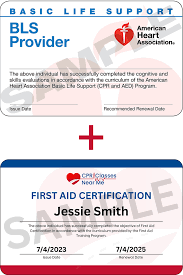Mastering Life-Saving Skills: The Importance of BLS Certification

The Importance of BLS Certification
Basic Life Support (BLS) certification is a crucial skill that can save lives in emergency situations. Whether you are a healthcare professional, first responder, or simply a concerned citizen, having BLS certification can make a significant difference in critical moments.
What is BLS Certification?
BLS certification teaches individuals how to recognize life-threatening emergencies, provide CPR, use an automated external defibrillator (AED), and assist choking victims. These skills are essential in situations where immediate intervention is needed to sustain life until professional help arrives.
Who Should Get BLS Certified?
BLS certification is recommended for healthcare providers such as doctors, nurses, paramedics, and other medical personnel. However, non-healthcare professionals can also benefit from BLS training to be prepared for emergencies at home, work, or in public settings.
The Benefits of BLS Certification
- Ability to Save Lives: With BLS training, individuals can confidently respond to cardiac arrest, choking incidents, and other life-threatening emergencies.
- Increased Confidence: Being certified in BLS gives individuals the knowledge and skills to act quickly and decisively in emergency situations.
- Career Advancement: Many healthcare professions require BLS certification as a prerequisite for employment or advancement opportunities.
- Community Contribution: By obtaining BLS certification, individuals contribute to building a safer and more prepared community.
Conclusion
BLS certification is not just a valuable credential—it is a potentially life-saving skill that everyone should consider acquiring. Whether you pursue it for professional reasons or personal preparedness, being trained in basic life support can make a significant impact when seconds count the most.
Understanding BLS Certification: Key Differences, Basics, and Comparisons with CPR
Is a BLS the same as CPR?
Many people often wonder if Basic Life Support (BLS) is the same as CPR. While there is some overlap between the two, they are not exactly the same. BLS encompasses a broader set of skills beyond CPR, including the use of an automated external defibrillator (AED) and assisting with choking incidents. CPR, on the other hand, specifically focuses on chest compressions and rescue breaths to maintain blood circulation and oxygenation in a person experiencing cardiac arrest. Both BLS and CPR training are essential for individuals seeking to respond effectively to life-threatening emergencies and provide critical care until professional help arrives.
What is the BLS training basic?
The BLS training basics cover essential life-saving techniques such as cardiopulmonary resuscitation (CPR), proper use of an automated external defibrillator (AED), and assisting individuals who are choking. Participants learn how to recognize and respond to cardiac emergencies, providing crucial support until professional help arrives. BLS training emphasizes the importance of quick action, effective chest compressions, and maintaining the airway open for optimal outcomes in life-threatening situations. By mastering these fundamental skills, individuals can confidently step in during emergencies and potentially save lives.
What BLS means?
Basic Life Support (BLS) refers to the fundamental level of medical care provided to individuals in life-threatening situations. BLS techniques include cardiopulmonary resuscitation (CPR), using an automated external defibrillator (AED), and assisting with choking incidents. BLS certification equips individuals with the necessary skills to recognize emergencies, intervene effectively, and potentially save lives until professional help arrives. Understanding what BLS means is essential for anyone seeking to be prepared for emergency situations and play a proactive role in ensuring the well-being of others.
Is BLS harder than CPR?
When comparing Basic Life Support (BLS) and CPR, it’s important to understand that BLS is a more comprehensive and advanced form of CPR. While CPR focuses on chest compressions and rescue breaths for individuals in cardiac arrest, BLS includes additional skills such as using an automated external defibrillator (AED), assessing and managing a patient’s airway, and providing ventilation support. Therefore, it can be said that BLS encompasses CPR skills but also expands upon them with additional lifesaving techniques. Both BLS and CPR require proper training and practice to execute effectively in emergency situations, emphasizing the importance of acquiring the necessary skills through certification courses.


Leave a Comment